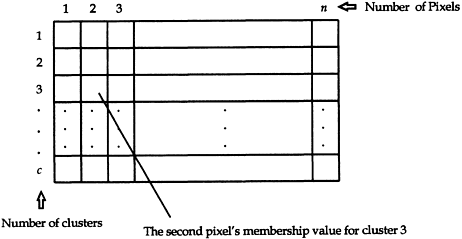63.
| [Cover] [Contents] [Index] |
Page 154
with fuzzy means and fuzzy boundaries, and is less dependent on the initial state of clustering. The algorithm is described as follows.
Let  , be a finite subset of Rd, the d dimensional real number vector space (e.g. where three features are used for clustering, d= 3). Let the integer c, n≥c>2, denote the number of fuzzy subsets. Thus, a fuzzy c partition of X can be represented by a (c×n) matrix U in which each entry of U, denoted by uik, satisfies the following two constraints:
, be a finite subset of Rd, the d dimensional real number vector space (e.g. where three features are used for clustering, d= 3). Let the integer c, n≥c>2, denote the number of fuzzy subsets. Thus, a fuzzy c partition of X can be represented by a (c×n) matrix U in which each entry of U, denoted by uik, satisfies the following two constraints:
 |
(4.12) |
In the case of image classification, n will be the number of pixels, and c is the number of clusters. The resulting matrix is shown in Figure 4.3. The value uik corresponding to the entry at the location (i, k) stores the kth pixel’s membership value for class i (see Figure 4.3). Note that all the entries in a given column must sum to 1 as specified in Equation (4.12).
The clustering criterion used in the fuzzy c-means algorithm is based on minimising the generalised within-groups sum of square error function Jm:
 |
(4.13) |
 is the vector of cluster centres (i.e. the means of the clusters), with vi
is the vector of cluster centres (i.e. the means of the clusters), with vi  Rd, and m is the membership weighting exponent, 1≤ m<∞. The term (xk−ki)2 in Equation (4.13) can be replaced by the Mahalanobis distance (Chapter 2), the calculation of which requires the fuzzy covariance matrix, which is introduced in Equation (4.18). For m>1 and
Rd, and m is the membership weighting exponent, 1≤ m<∞. The term (xk−ki)2 in Equation (4.13) can be replaced by the Mahalanobis distance (Chapter 2), the calculation of which requires the fuzzy covariance matrix, which is introduced in Equation (4.18). For m>1 and

Figure 4.3 The fuzzy c-means clustering membership matrix
| [Cover] [Contents] [Index] |
EAN: 2147483647
Pages: 354